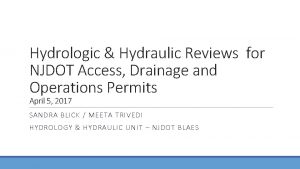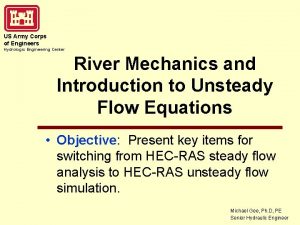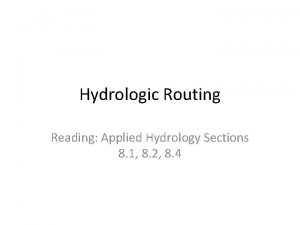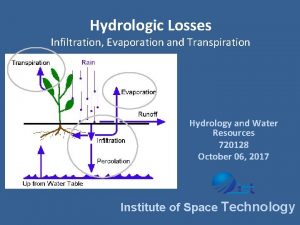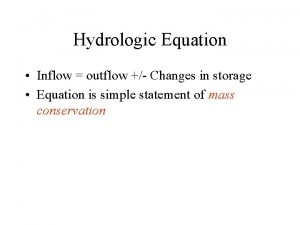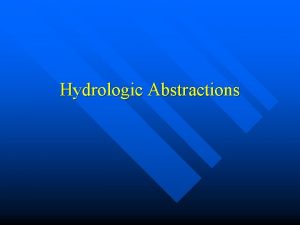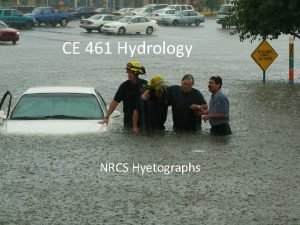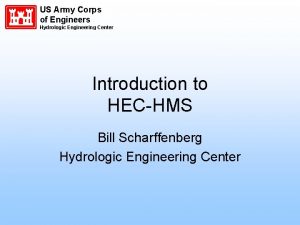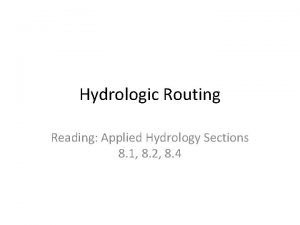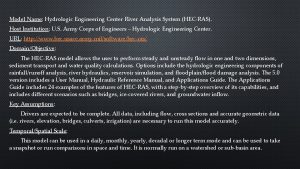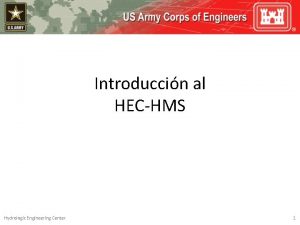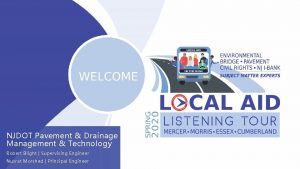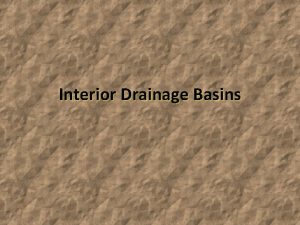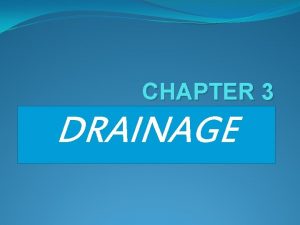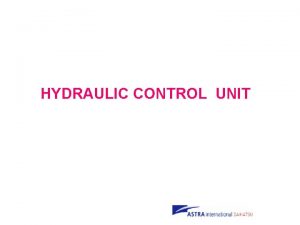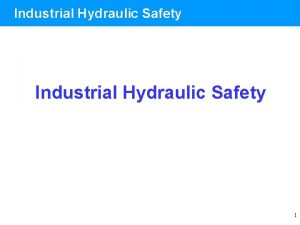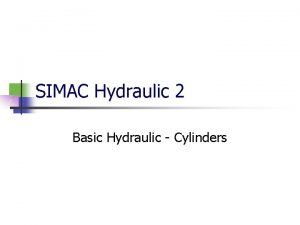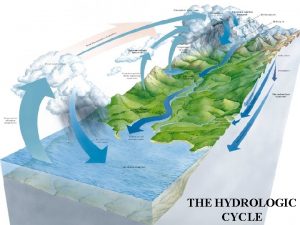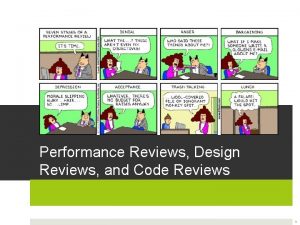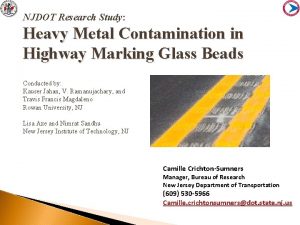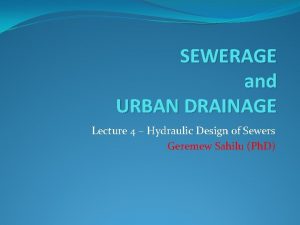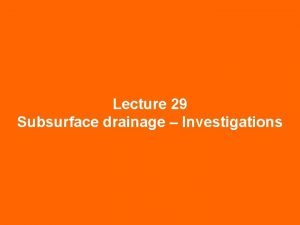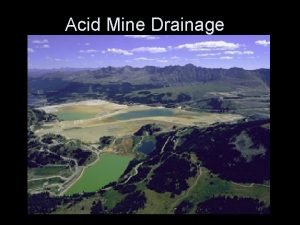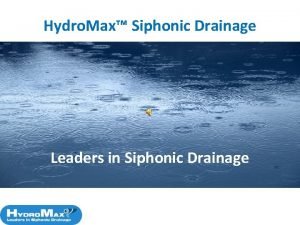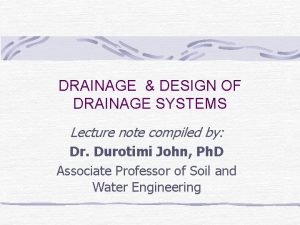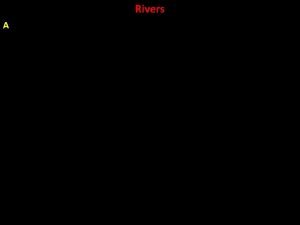Hydrologic Hydraulic Reviews for NJDOT Access Drainage and























- Slides: 23

Hydrologic & Hydraulic Reviews for NJDOT Access, Drainage and Operations Permits April 5, 2017 SANDRA BLICK / MEETA TRIVEDI HYDROLOGY & HYDRAULIC UNIT – NJDOT BLAES

Major Access Permits & Operations Permits Typically required when…. • entering DOT ROW, updating land use of the property, lot line is updated or discharging to NJDOT System • Permit group distributes projects to NJDOT SMEs (Subject Matter Experts) for review and approval based on discipline (e. g. , Traffic, Roadway Geometry, Pavement, Utilities, Drainage) • Drainage portion reviewed by Hydrology & Hydraulics Unit

Stormwater Standards for Project Reviews that Impact DOT Drainage or Roadways • Access Checklist • NJDEP SWM rules and NJDOT Water quantity impacts at each point of discharge • New curbing on the state road which was umbrella section in existing condition, triggers water quality in proposed condition

Typical H&H Issues on Access Permits • Project description – total area of disturbance and net increase in impervious surface • Points of Interest • New discharge to DOT system (changing existing drainage pattern) • Projects where gas station is proposed, petroleum pollutants treatment is required

Typical H&H Issues on Access Permits • Existing and proposed conditions drainage area maps • Infiltration Basin Designs • Soil Testing results • Maintenance plan for BMPs • Are NJDEP or other permits required?

H&H Issues: Points of Interest • Impact on NJDOT drainage system, roadways, and discharges • POI often combined on general direction of drainage • POI does not address impact to Drainage System

POI: Existing Conditions

POI: Proposed Conditions • Peak Evaluation based on site • Peak Reduction must be met for site AND Proposed Drainage Area • Maintain or reduce quantities at POI 1 for drainage capacity OR • Evaluate drainage system capacity from POI 1 to POI 2 POI 1

Issues: New Discharge to NJDOT System • Existing drainage patterns to be maintained • New discharges must be shown to be necessary

New Discharge to NJDOT • Additional permits not justification for new discharge • Allowed in very limited circumstances

Water Quantity • SWM Rules: Comply with reduction requirements • NJDOT Criteria: No increase in drainage flow rate (2, 10, 25 and 100) • Impacts need to be addressed at each point of discharge • Pipe connecting to NJDOT drainage system must match with the roadway design frequency ◦ 10 or 15 -year, depending on roadway • Inlets spread and pipe capacity analysis is required • Infiltration rate must be considered zero for infiltration basin

Water Quality & GW Recharge • Treatment for petroleum pollutants • If roadway umbrella section is converted to roadway curbing, additional impervious area need to be addressed for water quality • Maintain 100% of existing groundwater recharge or infiltrate increase in 2 -year volume

Typical H&H Issues on Access Permits • Infiltration Basin Designs • Soil Testing results • Maintenance plan for BMPs

H&H Issues: Infiltrating Basins ◦ Basins where infiltration criteria is missed ◦ Underground Basins ◦ Combined Infiltration/Detention Basins ◦ Infiltration Basins for projects exempt from SWM rules ◦ Infiltration basins with overflows to DOT in the event of failure ◦ DOT has criteria for discharges to DOT system beyond NJAC 7: 8

Infiltration Issues • Infiltration/exfiltration used for peak reduction analysis • Infiltration contact with water from gasoline stations • Mounding analysis not performed to determine draindown time

Infiltration Issues • Soil Profile Pit • Missing elevations • Missing SHWT • Not deep enough • Insufficient information to support mounding analysis • Permeability tests not acceptable

Groundwater Recharge • Not required in previously developed portions of PA-1 ◦ Areas in PA-1 with trees and shrubs still require GW recharge • Unknown Soil Types: Cut and Fill, Urban Lands, etc. ◦ Assumed to be HSG “D” without soil testing

Infiltration Issues: Groundwater Mounding

Groundwater Mounding: USGS Proposed infiltration depth is product of recharge/infiltration rate and time R & t can be revised to determine if it will drain in 72 hours. Remaining values should not be changed.

Other Issues • Other agency SWM approvals ◦ No automatic NJDOT approval and vice versa ◦ NJDOT has other criteria ◦ Minimal review of projects which do not impact NJDOT system • Privately owned pipes in NJDOT ROW – typically prohibited • Moving/changing existing channel near NJDOT roadway – cannot increase flooding regardless of Drainage Area

Other Issues • Assumed to be exempt from groundwater recharge requirement – not previously developed areas • Maintenance Plan – Does not meet NJAC 7: 8 -5. 8 (Responsible parties, cost estimates) • Rational method used for basin routings (or no assessment of critical duration storm)

Other Issues • Construction of project commenced prior to DOT approval • Municipal decision - Property not owned by NJDOT • NJDOT review not based on construction which took place • Has caused issues where approval could not be obtained to tie into NJDOT • Approved plans based on permeability rate/SWHT unable to be achieved during construction • Call us as soon as you know about the issue

Contact Information - NJDOT H&H Unit General Number: (609) 530 -5673 Sandy Blick: Sandra. Blick@dot. nj. gov : (609) 530 -2283 Meeta Trivedi: Meeta. Trivedi@njdot. nj. gov : (609) 530 -5363
 Njdot drainage design manual
Njdot drainage design manual Hydrologic continuity equation
Hydrologic continuity equation Njdot haps
Njdot haps Hydrologic engineering center
Hydrologic engineering center Reservoir flood routing worked examples
Reservoir flood routing worked examples Hydrologic routing
Hydrologic routing Hydrologic losses
Hydrologic losses Hydrologic equation
Hydrologic equation Hydrologic abstractions
Hydrologic abstractions Rickley hydrologic
Rickley hydrologic Continuity equation hydrology
Continuity equation hydrology Hydrologic engineering center
Hydrologic engineering center Water cycle the hydrologic cycle
Water cycle the hydrologic cycle Lumped flow routing
Lumped flow routing Hydrologic engineering center
Hydrologic engineering center Hydrologic engineering center
Hydrologic engineering center Terminal access controller access control system plus
Terminal access controller access control system plus Terminal access controller access-control system
Terminal access controller access-control system Kontinuitetshantering
Kontinuitetshantering Novell typiska drag
Novell typiska drag Nationell inriktning för artificiell intelligens
Nationell inriktning för artificiell intelligens Returpilarna
Returpilarna Varför kallas perioden 1918-1939 för mellankrigstiden
Varför kallas perioden 1918-1939 för mellankrigstiden En lathund för arbete med kontinuitetshantering
En lathund för arbete med kontinuitetshantering
